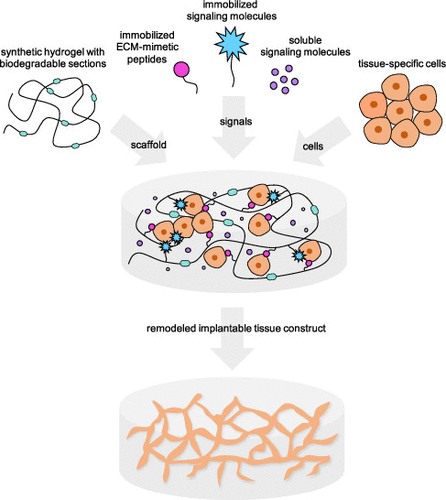当前位置:
X-MOL 学术
›
Bioconjugate Chem.
›
论文详情
Our official English website, www.x-mol.net, welcomes your feedback! (Note: you will need to create a separate account there.)
Synthetic ECM: Bioactive Synthetic Hydrogels for 3D Tissue Engineering.
Bioconjugate Chemistry ( IF 4.7 ) Pub Date : 2020-08-10 , DOI: 10.1021/acs.bioconjchem.0c00270 Asli Z Unal 1 , Jennifer L West 1
Bioconjugate Chemistry ( IF 4.7 ) Pub Date : 2020-08-10 , DOI: 10.1021/acs.bioconjchem.0c00270 Asli Z Unal 1 , Jennifer L West 1
Affiliation

|
The specific microenvironment that cells reside in fundamentally impacts their broader function in tissues and organs. At its core, this microenvironment is composed of precise arrangements of cells that encourage homotypic and heterotypic cell–cell interactions, biochemical signaling through soluble factors like cytokines, hormones, and autocrine, endocrine, or paracrine secretions, and the local extracellular matrix (ECM) that provides physical support and mechanobiological stimuli, and further regulates biochemical signaling through cell–ECM interactions like adhesions and growth factor sequestering. Each cue provided in the microenvironment dictates cellular behavior and, thus, overall potential to perform tissue and organ specific function. It follows that in order to recapitulate physiological cell responses and develop constructs capable of replacing damaged tissue, we must engineer the cellular microenvironment very carefully. Many great strides have been made toward this goal using various three-dimensional (3D) tissue culture scaffolds and specific media conditions. Among the various 3D biomimetic scaffolds, synthetic hydrogels have emerged as a highly tunable and tissue-like biomaterial well-suited for implantable tissue-engineered constructs. Because many synthetic hydrogel materials are inherently bioinert, they minimize unintentional cell responses and thus are good candidates for long-term implantable grafts, patches, and organs. This review will provide an overview of commonly used biomaterials for forming synthetic hydrogels for tissue engineering applications and techniques for modifying them to with bioactive properties to elicit the desired cell responses.
中文翻译:

合成ECM:用于3D组织工程的生物活性合成水凝胶。
细胞所处的特定微环境从根本上影响其在组织和器官中的广泛功能。这种微环境的核心是鼓励细胞进行同型和异型细胞相互作用的精确排列,通过诸如细胞因子,激素和自分泌,内分泌或旁分泌的可溶性因子以及局部细胞外基质(ECM)进行的生化信号传导提供物理支持和力学生物学刺激,并通过细胞-ECM相互作用(如黏附和生长因子螯合)进一步调节生化信号传导。在微环境中提供的每个提示指示细胞行为,并因此指示执行组织和器官特定功能的总体潜力。因此,为了概括生理细胞反应并开发能够替代受损组织的构建体,我们必须非常仔细地设计细胞微环境。使用各种三维(3D)组织培养支架和特定的培养基条件,已经朝着这个目标迈出了很大的步伐。在各种3D仿生支架中,合成水凝胶已成为高度可调节的,类似于组织的生物材料,非常适合植入组织工程化的构造。由于许多合成的水凝胶材料具有固有的生物惰性,因此可以最大程度地减少意外细胞反应,因此是长期可植入移植物,贴片和器官的良好候选者。
更新日期:2020-08-10
中文翻译:

合成ECM:用于3D组织工程的生物活性合成水凝胶。
细胞所处的特定微环境从根本上影响其在组织和器官中的广泛功能。这种微环境的核心是鼓励细胞进行同型和异型细胞相互作用的精确排列,通过诸如细胞因子,激素和自分泌,内分泌或旁分泌的可溶性因子以及局部细胞外基质(ECM)进行的生化信号传导提供物理支持和力学生物学刺激,并通过细胞-ECM相互作用(如黏附和生长因子螯合)进一步调节生化信号传导。在微环境中提供的每个提示指示细胞行为,并因此指示执行组织和器官特定功能的总体潜力。因此,为了概括生理细胞反应并开发能够替代受损组织的构建体,我们必须非常仔细地设计细胞微环境。使用各种三维(3D)组织培养支架和特定的培养基条件,已经朝着这个目标迈出了很大的步伐。在各种3D仿生支架中,合成水凝胶已成为高度可调节的,类似于组织的生物材料,非常适合植入组织工程化的构造。由于许多合成的水凝胶材料具有固有的生物惰性,因此可以最大程度地减少意外细胞反应,因此是长期可植入移植物,贴片和器官的良好候选者。



























 京公网安备 11010802027423号
京公网安备 11010802027423号